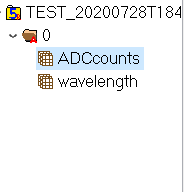Mini Spectrometer Raw Data
This data product is in-situ measurement of the bioluminescence emission collected by a combination of 5 spectrometers and 1 low light camera. The readout data is for all the spectrometers and there will be a file for each measurement.
Oceans 3.0 API filter: dataProductCode=MSRD
Formats
HDF5
Oceans 3.0 API filter: extension=hdf5
HDF supports n-dimensional datasets and each element in the dataset may itself be a complex object and it consists of a file format for storing HDF5 data, a data model for logically organizing and accessing HDF5 data from an application, and the software (libraries, language interfaces, and tools) for working with this format.
File Format
The HDF5 File Format is defined by and adheres to the HDF5 File Format Specification, which specifies the bit-level organization of an HDF5 file on storage media. In general users do not need to know details about it.
Data Model
The HDF5 Data Model, also known as the HDF5 Abstract (or Logical) Data Model consists of the building blocks for data organization and specification in HDF5. An HDF5 file (an object in itself) can be thought of as a container (or group) that holds a variety of heterogeneous data objects (or datasets). The datasets can be images, tables, graphs, and even documents, such as PDF or Excel.
The two primary objects in the HDF5 Data Model are groups and datasets.
Groups
HDF5 groups (and links) organize data objects. Every HDF5 file contains a root group that can contain other groups or be linked to objects in other files.
Working with groups and group members is similar in many ways to working with directories and files in UNIX. As with UNIX directories and files, objects in an HDF5 file are often described by giving their full (or absolute) path names.
/ signifies the root group.
/foo signifies a member of the root group called foo.
/foo/zoo signifies a member of the group foo, which in turn is a member of the root group.
Datasets
HDF5 datasets organize and contain the “raw” data values. A dataset consists of metadata that describes the data, in addition to the data itself. Datatypes, dataspaces, properties and (optional) attributes are HDF5 objects that describe a dataset. The datatype describes the individual data elements.
Example
The root group of this file looks like the attached image below and the metadata associated with that implies the following:
a) These values are auxiliary information that is not necessarily needed for interpreting the data, but can help in order to figure out what's wrong in case there should be something strange about the spectra.
b) CAL.xx are the polynomial coefficients that were used for the pixel to wavelength calibration. They are unique for each minispec device/channel and are provided by the manufacturer.
c) Timestamp of the recording, the exposure time, temperature and the UID of the minispec PCB (we use those UIDs for identifying our devices).
This example includes the following datasets:

